During this trip, we will embark on a journey to connect with my direct paternal ancestors, tracing our lineage from John Pearson (b1932) to Thomas (Tommy) Pearson (b1728). Tommy Pearson, the esteemed patriarch of the Pearson family, played a pivotal role in the settlement of the Miami Valley area, where he and his extended family established farms following the Greenville Treaty in 1795.
The direct paternal lineage encompasses a line of men, including my father, grandfather, great-grandfather, and so forth. As we traverse our ancestral path, we will also make stops to pay homage to other ancestors, who may not be part of the direct paternal line but share the same resting places in the cemeteries.
Our comprehensive round trip, starting and finishing in Richmond, Indiana, spans approximately 100 miles. Depending on the duration of our visits at each location, the entire journey will take us between 4 to 6 hours. Within the pages of this book, I have included captivating stories and intriguing facts associated with the various sites we will explore. My direct paternal fathers names will be bolded throughout the narrative.
Start from Richmond and go to Tipp City, Ohio
1.) Starting from Richmond, Indiana, take National Road 40 East until we get to Frederick Cemetery near Tipp City. We will visit our oldest and first ancestors buried in Ohio. These ancestors were the first to clear farms out of the thickets, forest and swamps that made the Miami Valley area so fertile for farms growing crops. Figure 1 below shows the route to the cemetery.
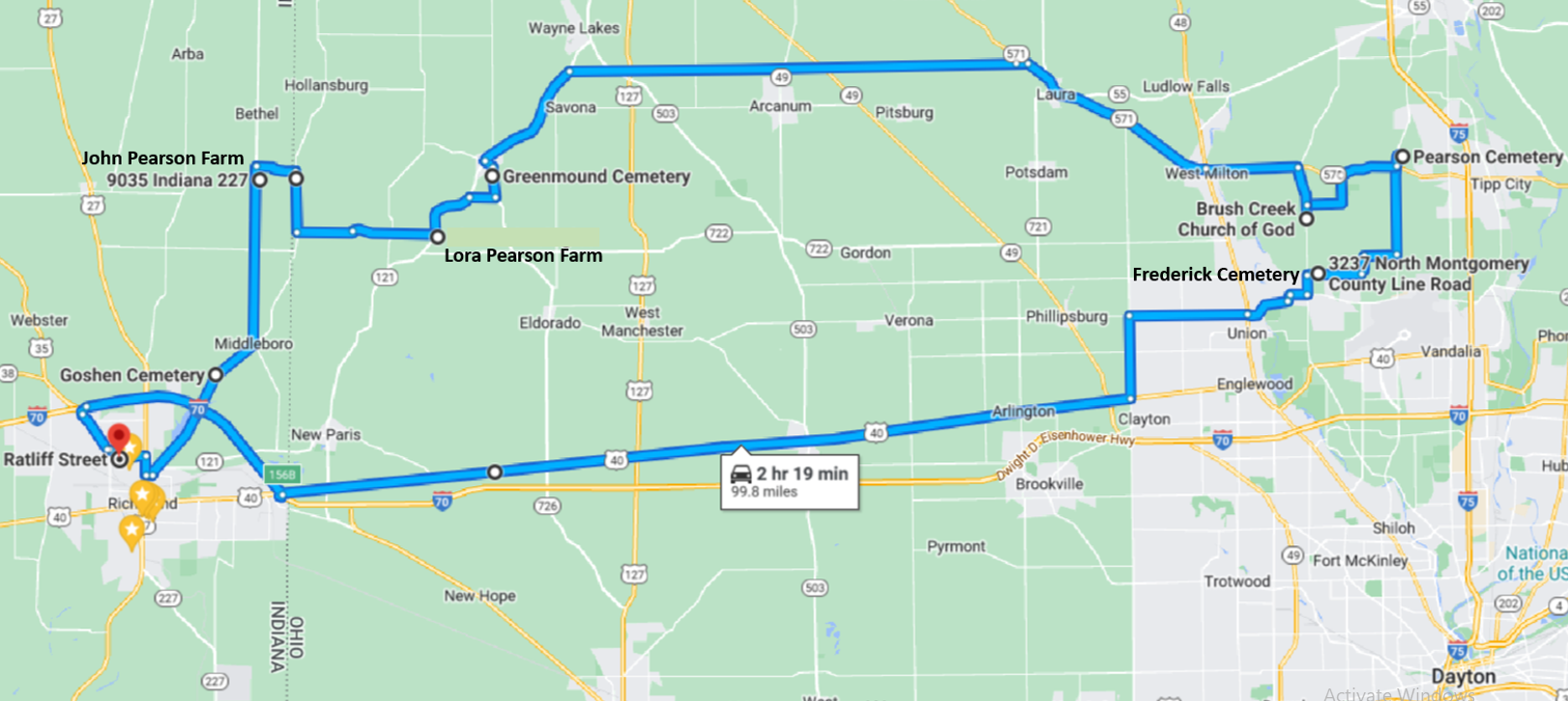
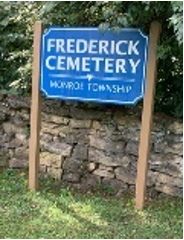
Frederick Cemetery
2) Our initial stop brings us to Frederick Cemetery, where we visit the final resting place of Thomas (Tommy) Pearson (b1728). A noteworthy detail about this cemetery is that the county line road takes a distinct curve around its perimeter. It is important to note that Tommy's 1st wife, Ann Powel Pearson (b1729), who is my ancestor, was buried in Pennsylvania, as she passed away about five decades before Tommy.
The Daughters of the American Revolution applied and then once approved, paid for a gravestone that outlined him a hero for fighting with the American Revolutionist.
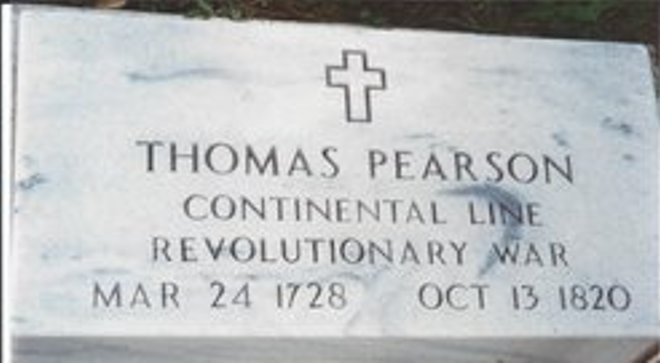
For Tommy, this is in error as he never fought in the revolutionary war and as a Quaker would have been against the war itself. Tommy was the patriarch ancestor that emigrated from Philadelphia, Pennsylvania, then to Bush Creek, South Carolina and then to the Miami County, Ohio area. Tommy is my 8th generation father and he lived for 92 years. He even outlived his son, Benjamin Pearson (b1766), my 7-generation father who lived for only 49 years. Both are buried at the Frederick Cemetery. Benjamin Pearson(b1766) is buried here along with his wife Elizabeth (b1772). This cemetery was also the first location of the Quaker’s Friends Meeting house. The map in figure 2 shows the Friends meeting house location in 1850.
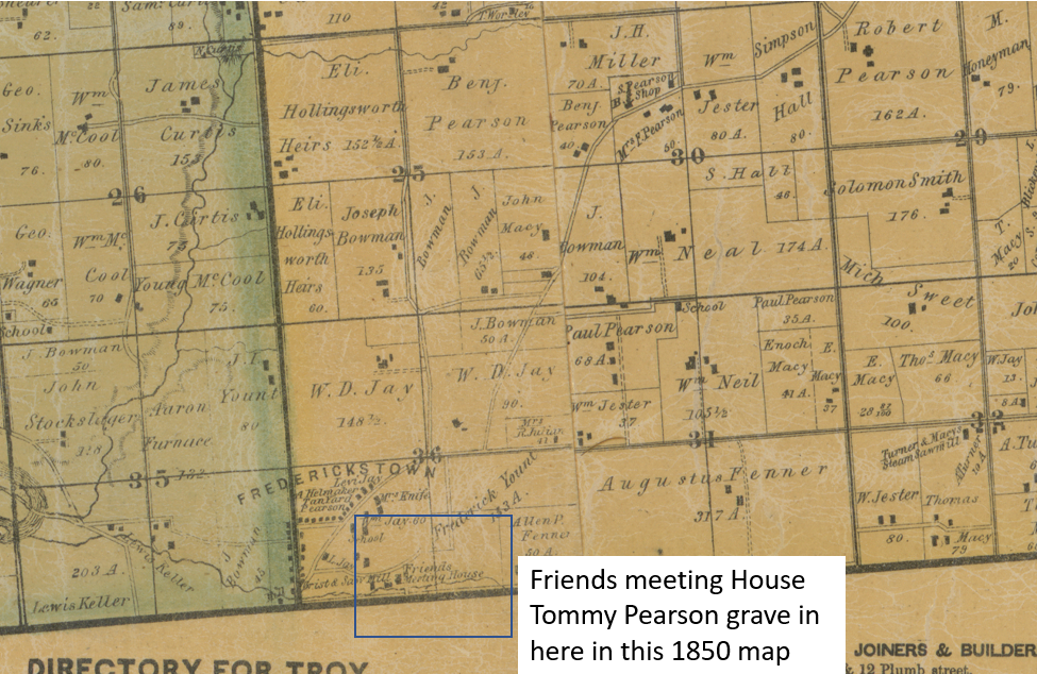
Tommy is the grandson of Thomas Pearson (b1653) who emigrated with his wife, Margery, on the voyage from Wilmslow, England to Philadelphia, Pennsylvania in 1683. You can read about their voyage and their lives on page 19 in “Pearson & Erk Genealogy Vikings Among Us” genology book by Tom E Pearson in 2015. In that same book you can also read “The story of Old Tommy” on page 23 and “Thomas Pearson’s family migration to Miami County, Ohio” on page 22 on how and why he and his family immigrated to the Miami Valley area. Attachment 1 and 2 at the end of this article has some of the story's you can read. At the gravesite in Frederick Cemetery, try to find Tommy’s son’s grave Benjamin Pearson (b1766) headstone who died 4 years earlier than his father. Benjamin’s wife Elizabeth Hall Pearson (b1772) is also buried here and Tommy’s 2nd wife Mary Pearson (b1739), however their gravestones are not legible. It is interesting that their gravesites are only 3 miles northwest of the Dayton, Ohio airport and only 200 years away. If Tommy was alive today, he would likely think he is in another world as we have gone from horse powered wagons to jet powered planes taking off in the air near his farm.
Pearson farms since 1804
3) After the Frederick Cemetery, drive west to Fredericks Pike, turn north and cross the Mill Creek River then immediately turn right on Road 12 (Ginhamsburg-Frederick Rd) and then onto Troy-Frederick Rd. On this road you will visit several generations of Pearson farms as Benjamin Pearson (b1766), my 7th generation father, and my later ancestors farmed the Brush Creek River area for 150 years from 1804 when they cleared the area for farmland until 1958 when Lester Earl (b1888), my great-grandfather, died at age 69. My father, John Pearson (b1932) and his brother Don Pearson was born in a house on this same road that Lester farmed before John’s family moved to a farm near New Madison, Ohio. John Pearson and Don was born at a house near a curve on Troy-Frederick Rd. Figure 3 below shows all the plotted farms and who owned them in the 1870s.
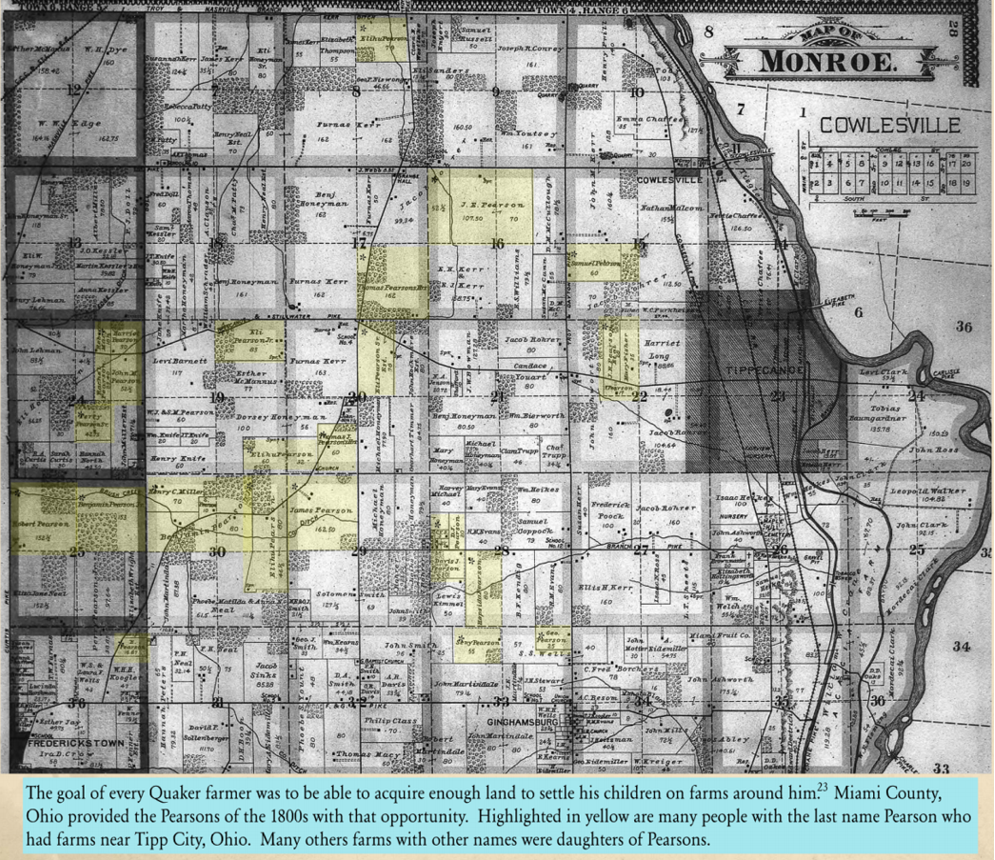
Pearson Cemetery
4.) After we visit the Pearson farms on Ginhamsburg-Frederick Rd, let’s go to the Pearson Cemetery at the Monroe Grange. Here are my 6th and 5thgeneration father’s graves, Joseph Pearson (b1792), and Benjamin Pearson jr. (b1824) buried behind the Monroe Grange. Joseph Pearson (b1792) wife was Delphina (b1800) and Benjamin Pearson’s (b1824) wife was Maria who are buried with the same headstone you see below.
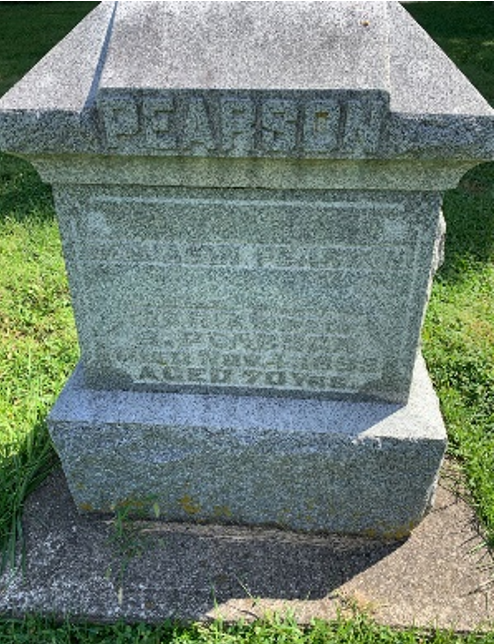
There was a Friends Meeting House next to this graveyard. Benjamin and Maria Pearson are the last Quakers in my ancestry. Their pictures are in figure 4 below. The land where the Pearson gravesite and the Monroe Grange sits on today was part of Thomas “Tommy” Pearson’s (b1728) farm, thus the name of the cemetery.
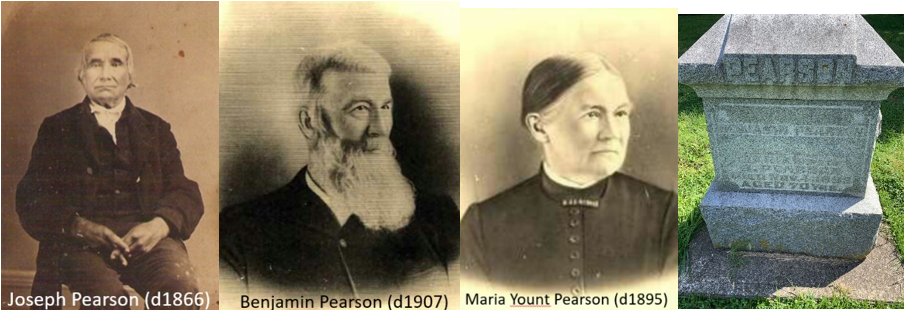
Brush Creek Church Cemetery
5) After we finish visiting the grave sites for Joseph and Benjamin, we will now travel to Brush Creek Church of God on Kessler-Frederick Rd just west of Tipp City, Ohio. To the side of the church are the graves of Davis Pearson (b1845) and Lester Pearson (b1888) my 4th and 3rdgeneration father. Their wives are buried next to each of them, Deborah (b1849) and Emma (b1889). Their pictures are in figure 5 below.
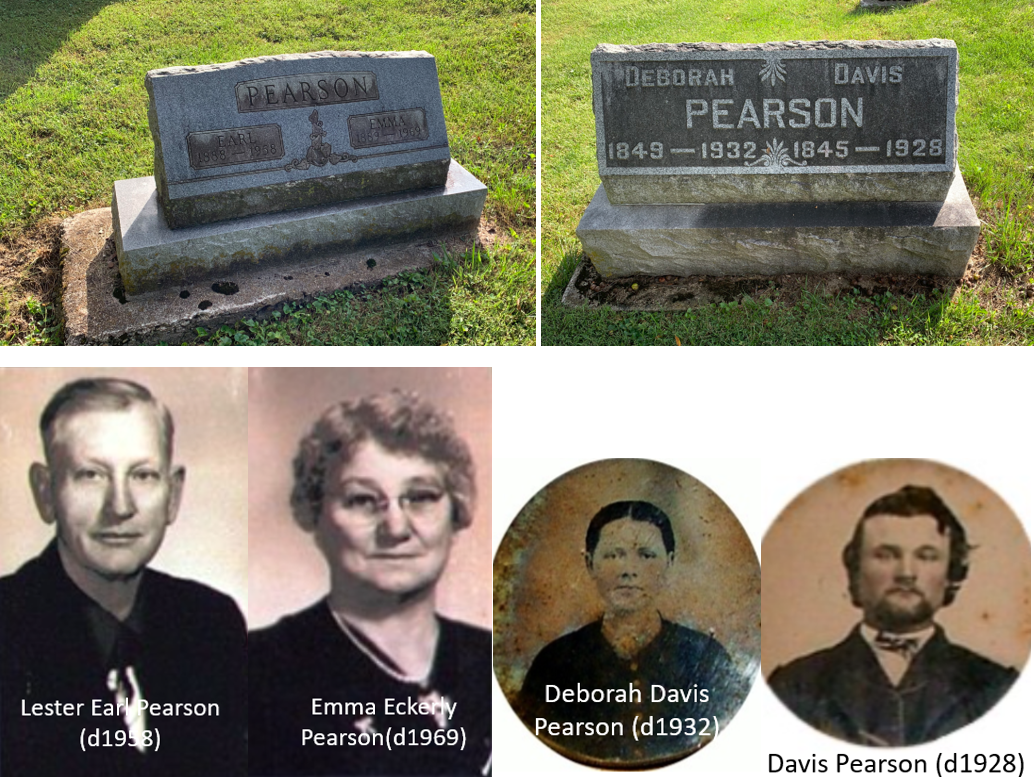
These ancestors attended the Brush Creek Church, however this church was not a Quaker meeting place. Lester and Emma’s home is in figure 6. It is assumed that since Davis and Deborah Pearson's gravesites are at the Brush River Church that this is the generation that left the Friends for good. Lora and Rose Pearson also attended this church.
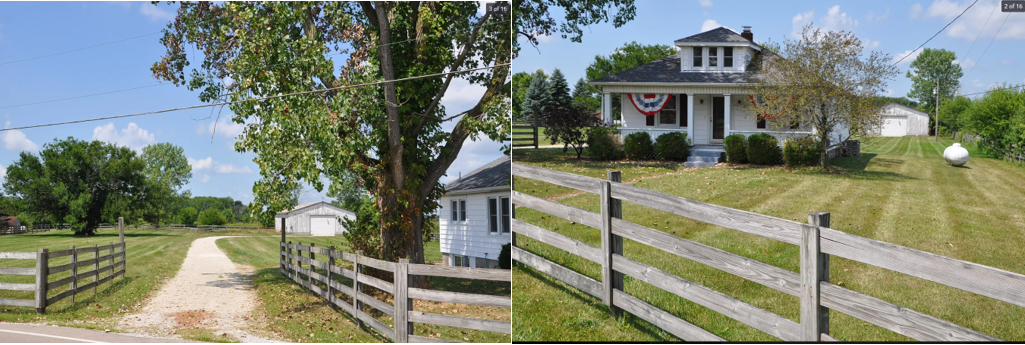
Emma’s parents who emigrated from Germany in 1871, Solomon and Caroline Eckerly, are buried at the Maple Hill Cemetery, just south of Tipp City, Ohio. Their gravesites are shown in figure 7 below.
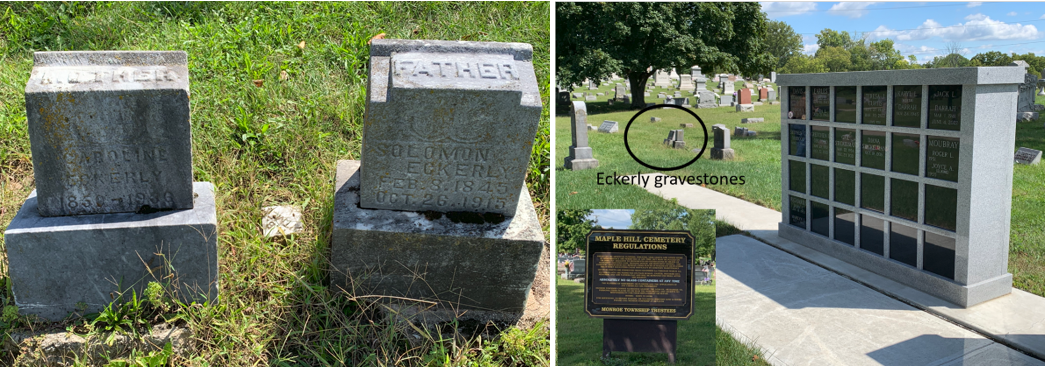
Glen Haven Memorial Gardens Cemetery
6) A side trip can be taken to see Rose Phyillaier Pearson’s (b1913) mother gravesite at Glen Haven Memorial Gardens Cemetery near Springfield, Ohio and her father gravesite at Graceland in Sidney, Ohio. Rose was married to Lora Pearson (b1909) and is my grandmother. This will add about 2 hours to the trip. Rose’s mom Lizzie Mote Phyillaier (b1891) is buried at Glen Haven Memorial Gardens Cemetery near the front entrance of the Glen Haven Chapel. Figure 8 below shows her gravestone and location.
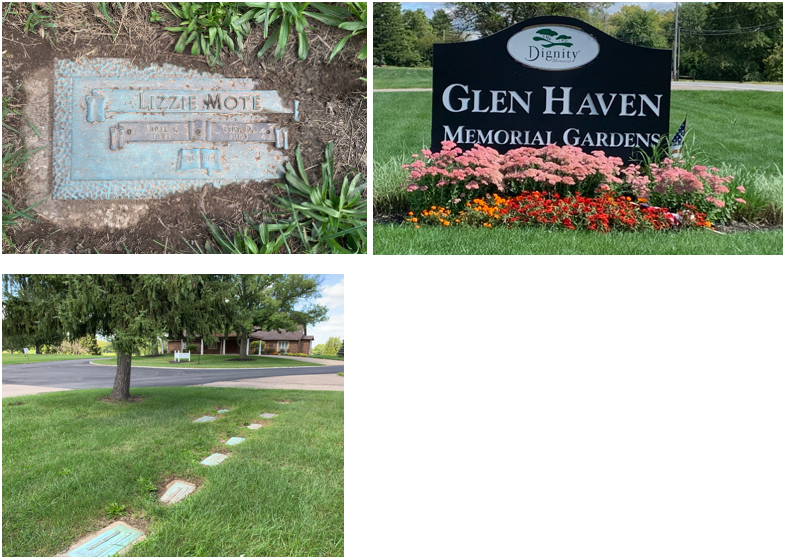
Lizzie and her 1st husband Lewis Phyillaier have an interesting story that is told in Attachment 3 at the end of this story. Lewis Phyillaier is buried in Sidney, Ohio at Graceland Cemetery. Figure 9 below shows his gravestone and location.
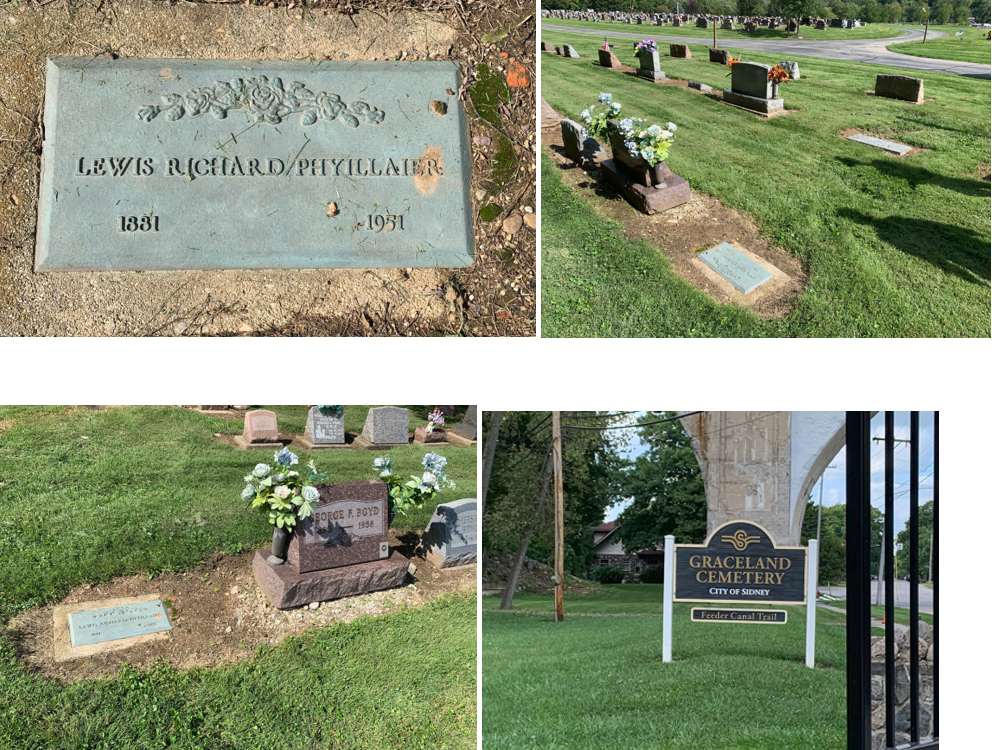
Green Mound Cemetery
7) We travel now to New Madison, Ohio to the Green Mound Cemetery where Rose (b1913) and Lora Pearson (b1909) my 2ndgeneration father and mother are buried. Lora and Rose had a farm 3 miles south of New Madison on highway 121. Figure 10 has the satellite view of farm location.
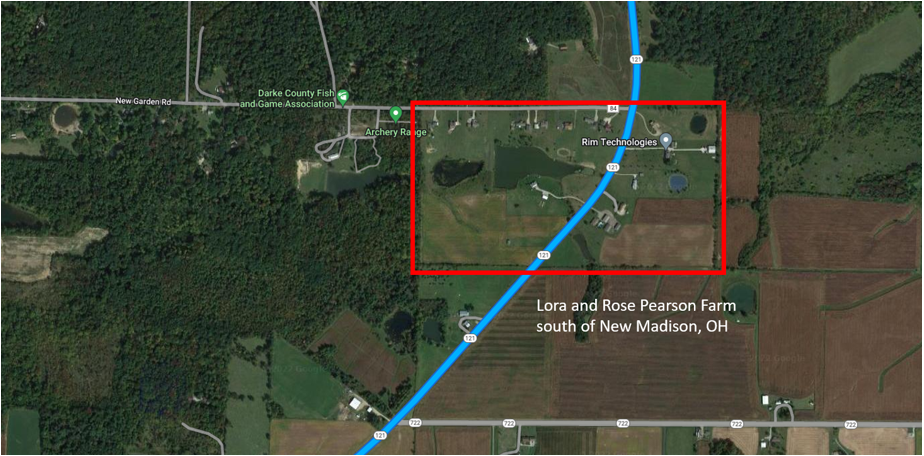
Please read “My Great Grandparent’s Journey” by Tom E. Pearson in Chapter 3 and 4 to learn more about their farm and my grandparents. Lora and Rose pictures are in figure 11 and gravesite location in figure 12.

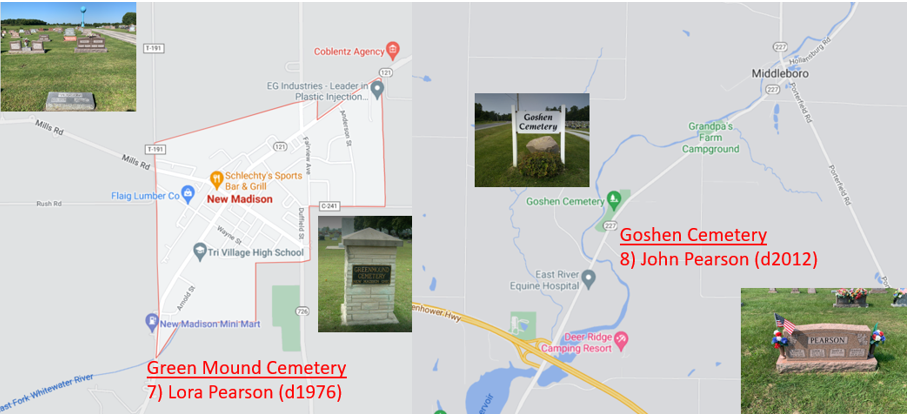
Goshen Cemetery
8. After visiting Rose and Lora’s farm we continue toward John and Elinor Pearson’s farm at 9035 St Rd 227. Their farm was located on 227 one mile north of Whitewater on the east side of the road where they lived for almost all their lives. Their pictures are in figure 11. We now go onward to Goshen Cemetery where John (b1932) and Elinor (b1932) Pearson are buried, my 1st generation father and mother.
9) We head back to Richmond, Indiana to complete the trip.
Bonus:
I will now add on a 20-hour road trip for to visit Thomas Pearson (b1653) and Enoch (b1690) gravesites near Philadelphia, Pennsylvania and Winchester, Virginia. Thomas Pearson (b1653) is the grandfather, and Enoch Pearson (1690) the father of Thomas (Tommy) Pearson (b1728) that we previously visited at the Fredericks Cemetery that I visited in September 2022.
Springfield Meeting House Cemetery
10) First, we will see Thomas Pearson (b1653) gravesite 10 miles west of Philadelphia. The drive from Richmond is 9 hours taking I70 and I76 most of the way. Thomas Pearson (b1653) immigrated to America in 1683. He lived on a farm called “Turtleback Farm” where there is a memorial monument today that marks his original homestead. Figure 13 has pictures of the monument and the original springhouse location. Use map in figure 14 on how to get there.
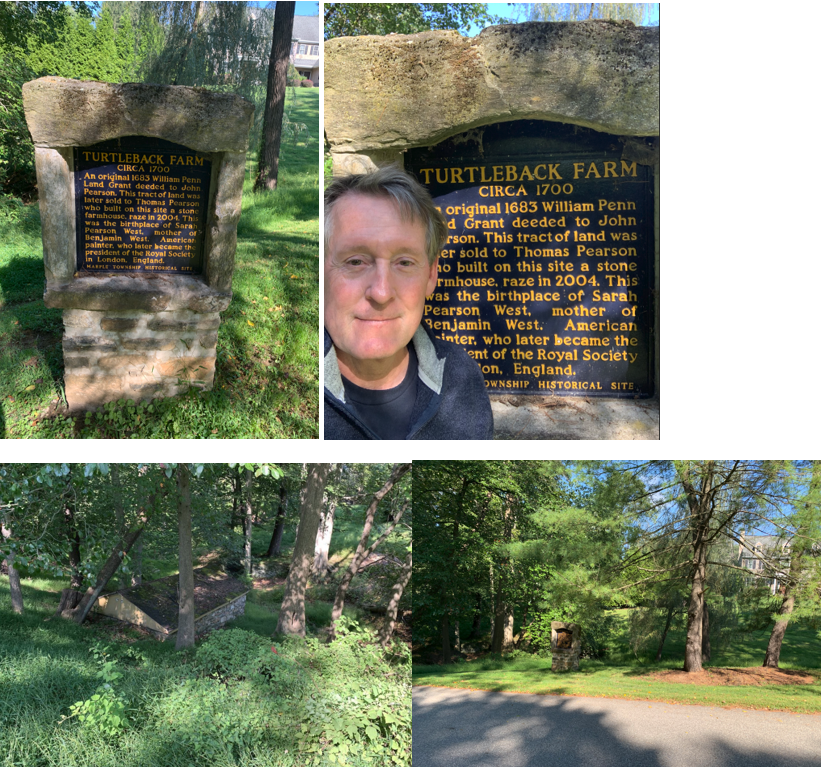
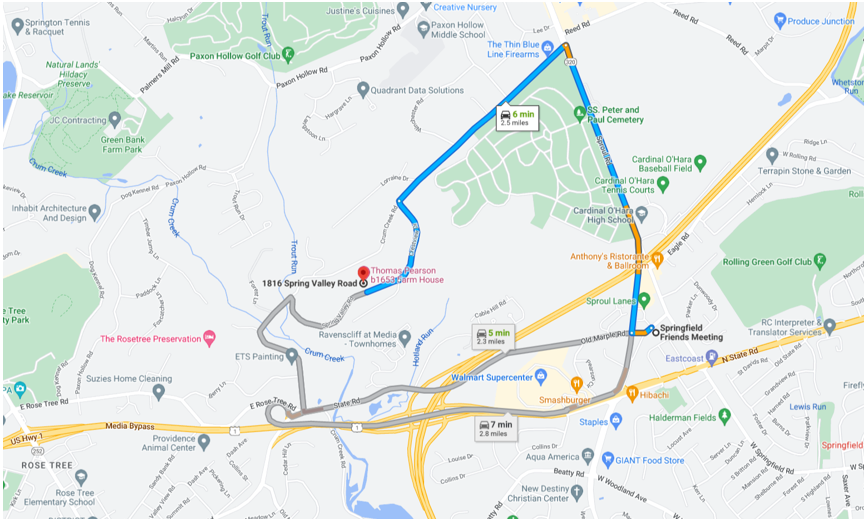
Figure 15 is the homestead that Thomas and his wife Margery cut out of the forest when they first arrived in America. Figure 13 has a picture of the refurbished springhouse where they got their water. A photo was taken of his home before it was torn down to build a new home at the site.
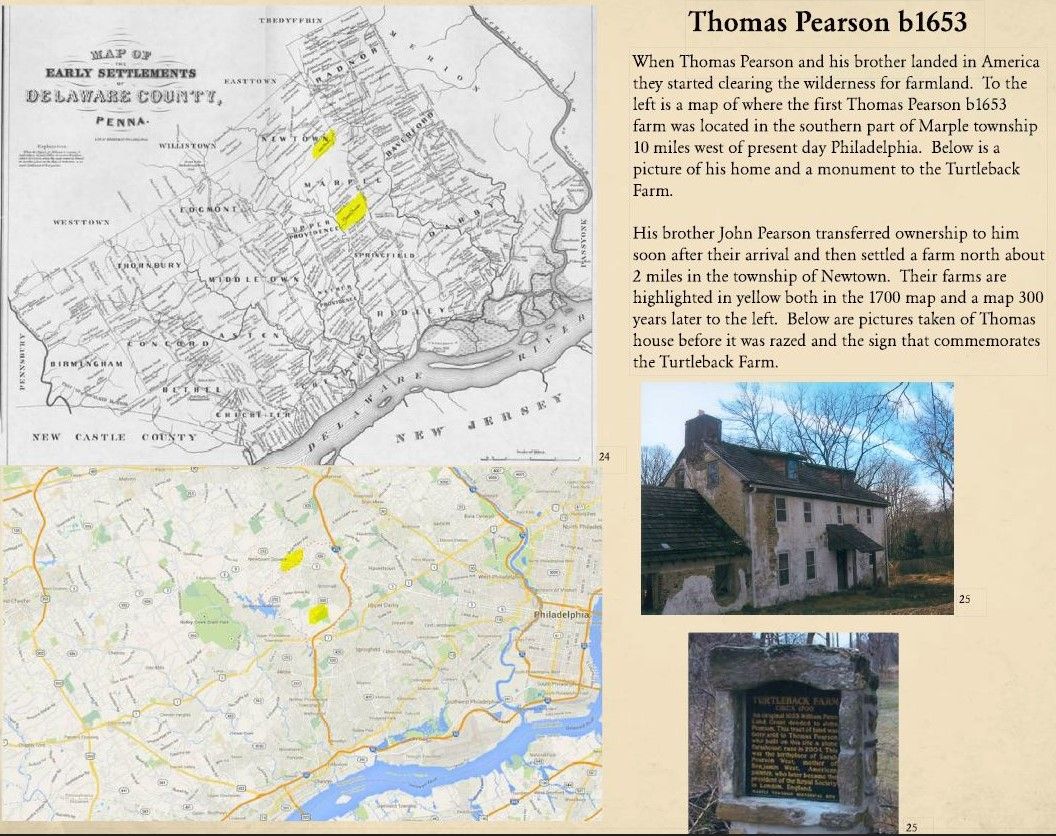
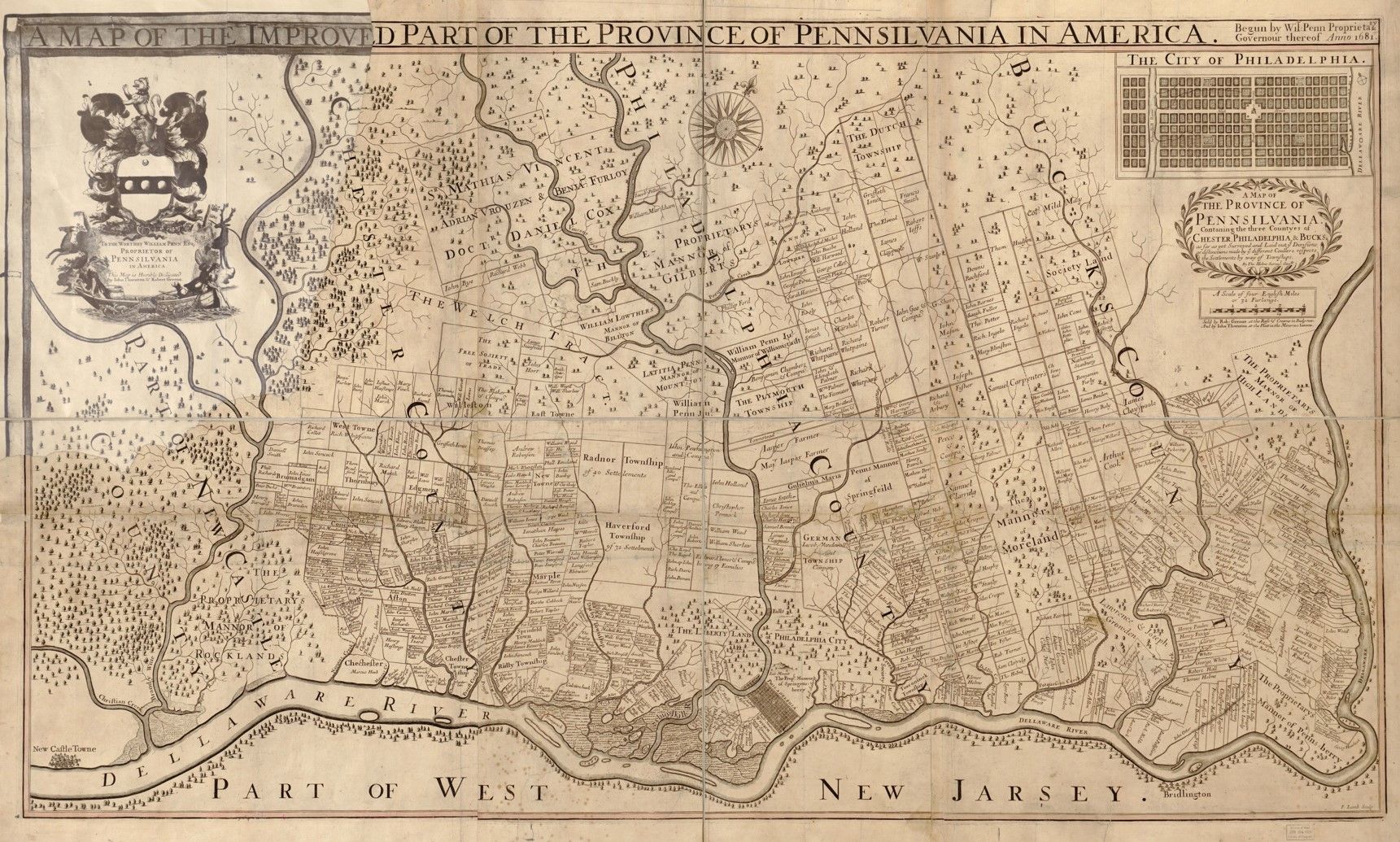
Next, we will go to the Springfield Friends Meeting house and graveyard. This is where Thomas Pearson (b1653) and his wife Margery (b1658) are buried. He is my 10th generation father. Figure 15 has pictures of the graveyard and meeting house. Please read “Tom Pearson Ancestry from England to Indiana” by Tom E. Pearson @ tomtepster.com to find out more about Thomas Pearson (b1653) and his journey to America.

Hopewell Meeting House Cemetery
11) Next, we will drive 3 ½ hours west towards Winchester, VA to Hopewell Meeting House and graveyard where Thomas Pearson (b1653) son, Enoch Pearson (b1690), is buried. Enoch is Thomas “Tommy” Pearson (b1728) father. He is my 9th generation father. This last visit will take you on the full trip of Pearson paternal ancestors from John Pearson (b1932), my father, to Thomas Pearson (b1653), my 10thgeneration father. Any further back you will need to go to Wilmslow, England to visit Lawrence Pearson (b1620) gravesite. Enoch Pearson (b1690) is buried in an unmarked grave near the Hopewell Meeting House. Figure 16 has pictures of the meeting house and graveyard. After the visit we will head back to Richmond, Indiana which will take 7 ½ hours by car.
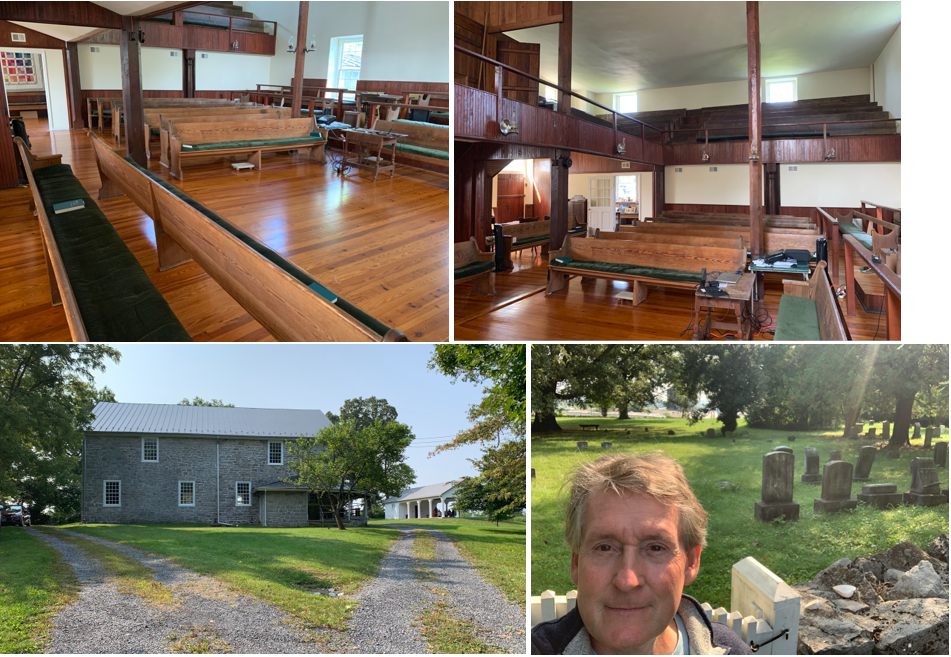
Attachment and pictures
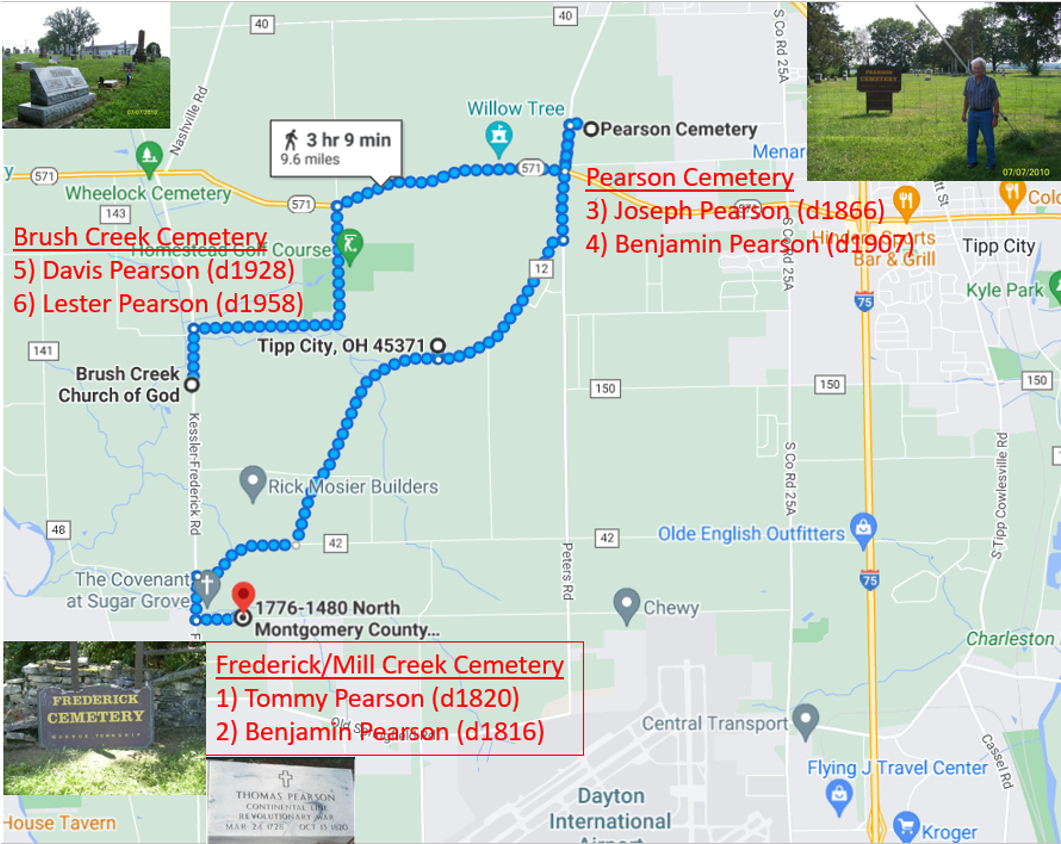
Figure 17: Map of the 3 graveyards near Tipp City and the ancestors buried in each.
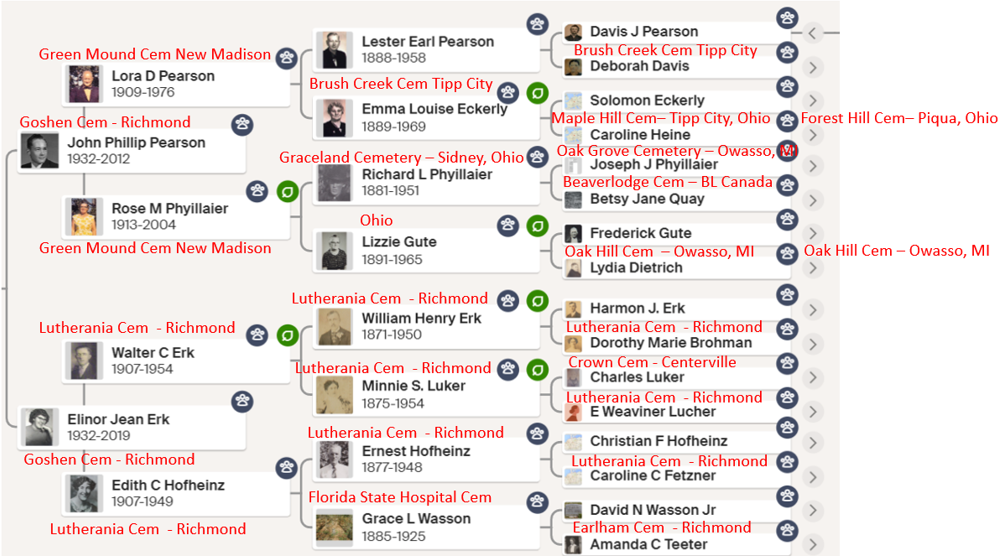
Figure 18: This tree has my last 4 generation of my ancestors and in red the graves sites they are buried.
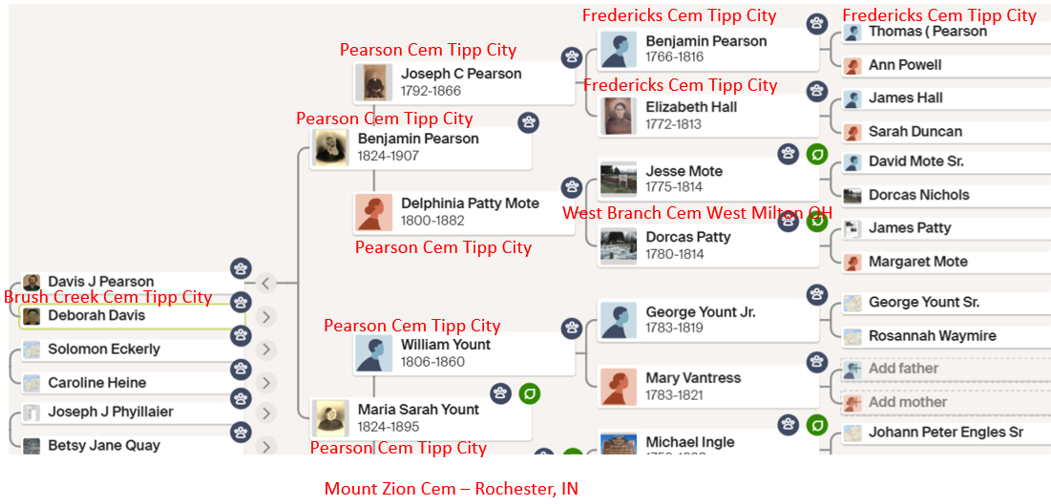
Figure 19: Has my Pearson ancestors from my 4th to 8th generation. In red the graves sites they are buried.
Attachment 1:
The Story of “Old Tommy”
“I will now give an account of some of the most prominent persons who came from Newberry and settled in the tree counties previously mentioned. Many of those emigrants being unknown for forgotten by the author of the Annals of Newberry, are not mentioned by him, and we need not wonder, for he was a boy at the time of their emigration. The traits of some, however, are given with almost surprising accuracy: and could he have known their subsequent lives it would no doubt have given him much satisfaction and would have been a supplement to the Annals.
The first I’ll mention is Thomas Pearson, “Little Old Tommy.” Who lived to the greatest age of any who came from Newberry, besides being the oldest emigrant to his township, and, as near as I can learn, country? Born in 1728, he was older than the Father of his Country, a fact which seemed to attach additional importance to him. In early life he lived in Philadelphia, following the trade of saddler and harness-maker.
Years before, and during the Revolution, he and his family resided in Newberry District and had their full share of its honors. Once, when a captive, his enemies required his serviced in saddlery and harness work, regardless of his lack of tools. He answered them by say in that ‘Neither wise men nor fools can work without tools’ the piquancy of which caused them to laugh and excuse him. He appears to have occupied the first seat in the ‘common Meetings’ of Friends.
A granddaughter of his told me that once during the solemn quiet of a meeting a partially insane woman come in with fruit in her apron and going up to him said, ‘Here, Mr. Pearson, I’ll give you the apples if you preach today” Being a harmless person they got rid of here in a quiet way, but whether or not the regarded her interruption as a rebuke upon their silent worship I was not informed. I think it was in 1805 or 1806, that Father Pearson left Newberry with a numerous retinue of children, grandchildren and one great-grandchild. Coming directly to Miami County they pitched their tents in proximity to the Jays and Jenkins, who had preceded them. It was not many years before his many descendants were settled comfortably around him and he saw teeming fields, in place of dark, tangled forests.
His wife died, and though in advanced age, he took another. A few years more and his walk became tremulous, his eyes grew dim, and his hearing blunted. The writer saw hm in 1820, when he had Old Dodson’s Three Warnings – He was lame, and deaf, and blind. He would walk only with support on both sides, could hear only by loud speaking in his ear, both day and night were alike to him. In this lamentable condition we may well suppose time hung heavy on his hands. Upon asking what time it was, if answered tone o’clock, he would say and repeat, ‘Ten o’clock, ten o’clock,’ striving, but in vain, to impress it upon his memory, for it would not be long before he repeated the question. The author, child as he was, pitied him striving, whose lamp of life, so nearly gone out, seemed to be leaving him rather impatient. How much the weight of blood upon his soul distressed Napoleon, we cannot know, but we do know he had his sight and hearing, which old Thomas Pearson had not. In natural ability they bear no comparison, neither did they in ambition. The first died in the calmness and quiet of Christian resignation, the second a few months after with his spirit deliriously engaged in the strife of battle and the rage of tempest around him.
In 1806, at the age of 78, “Little Old Tommy” crossed the Appalachian Mountains to settle in Miami County, Ohio where his children moved a few years earlier and were living. Though blind, he lived another fourteen years, until October 13, 1820, at the age of 92 years, 6 months, 20 days. He is buried in Mill Creek Cemetery in Miami County, Ohio at the Frederick Cemetery (aka Mill Creek Cemetery) near Tipp City, Ohio.
Thomas (Tommy) Pearson’s Family Migration to Miami County, Ohio
Thomas Pearson(b1728) grandchild of Thomas Pearson (b1653) who emigrated from England moved his family to farmland he bought near Bush River, South Caroline soon after his first wife died in 1773 from giving birth to their 8th child. Between 1760 and 1778 the drum beat of colonists opposing the British became swift and the Quakers in the Philadelphia area soon lost political influence because of their passive no-war beliefs that were perceived as friendly to the British. Moving south to get away from war drumbeat was an option for many Quakers including Tommy and his family. Bush River, South Carolina had a new Quaker settlement with fine land to farm and his family quickly grew into the community clearing farms there. He arrived in the fall of 1773, then remarried November 8th, 1775 to Mary Campbell, a widow, and then had 2 more children. They lived in the Bush River area for another 30 years from 1775-1806. In the spring/summer of 1806 his son Benjamin Pearson and many of his family including Tommy moved to the Miami Valley, Ohio area where a new wilderness could be cleared and turned into rich virgin farmland. The land was acquired from the Native Americans through the Treaty of Greenville. As the frontier opened the Pearson’s flourished in the Miami, Ohio area, mostly as farmers then other occupations for the next 7 generations.
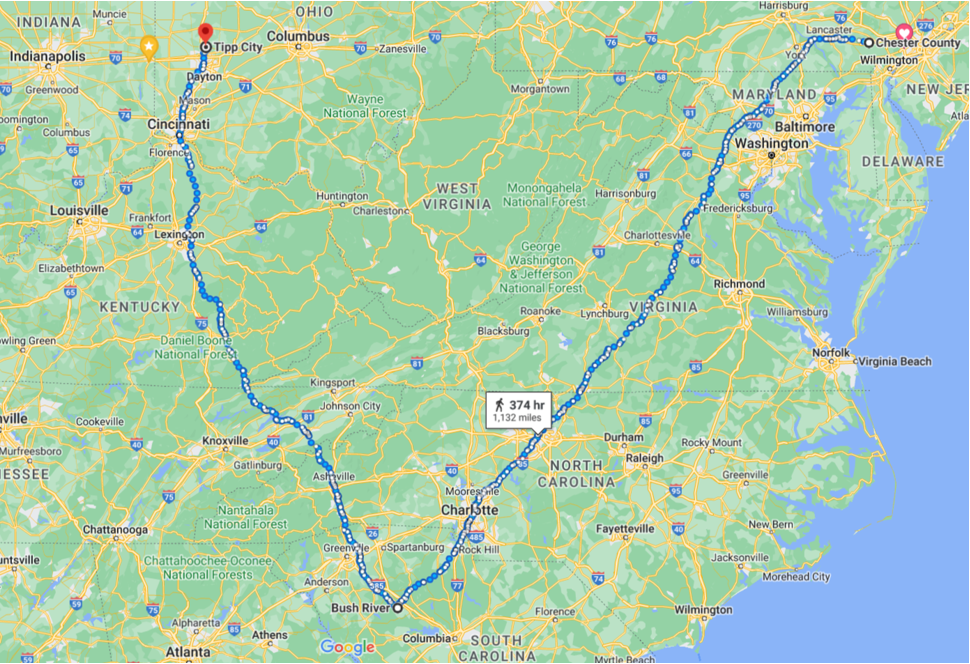
Attachment 2:
Quakers and Slavery
By 1800, the farms on Bush River, South Carolina had been worked for nearly half a century. By eighteenth century standards, they were close to becoming “old fields” their fertility reduced significantly. While hardly exhausted, they were no longer virgin land. But while they may not have been as rich as they had been when the first Friends arrived, they were much more in demand, partly from the simple increase in population, partly because of the growing demand for common lands, Increasingly, Quaker families found themselves competing not just with other small farmers, but with rich, even rapacious, cotton planters.
For Friends, however, slavery was not just an economic problem. It was a moral challenge as well. The search for new lands explains why the Bush River Friends looked west. Slavery explains why they looked northwest, across the Ohio River, instead of farther south into Georgia or Alabama or Mississippi where slavery was still practiced as would be the case with many of their neighbors.
Attachment 3:
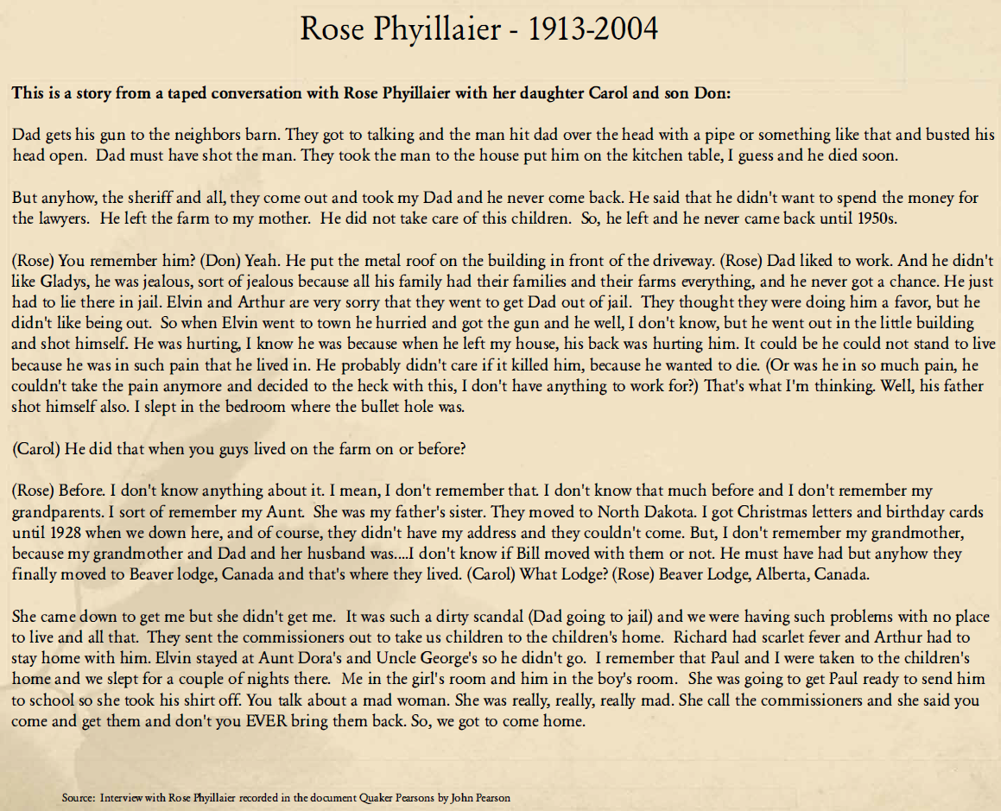
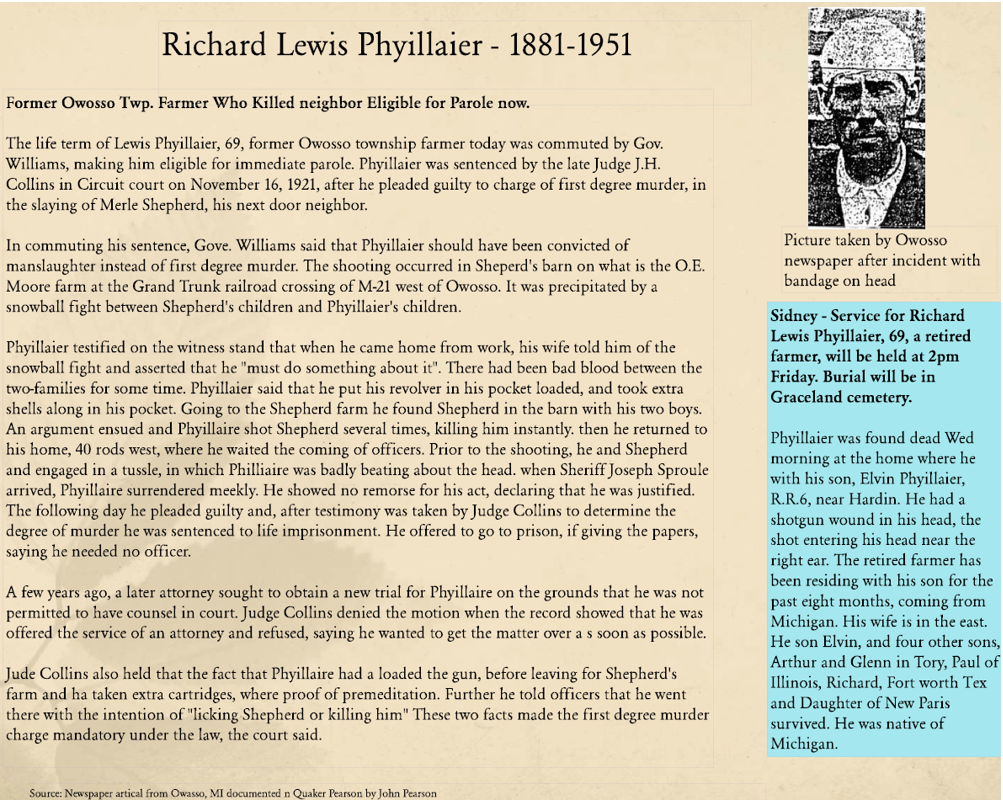
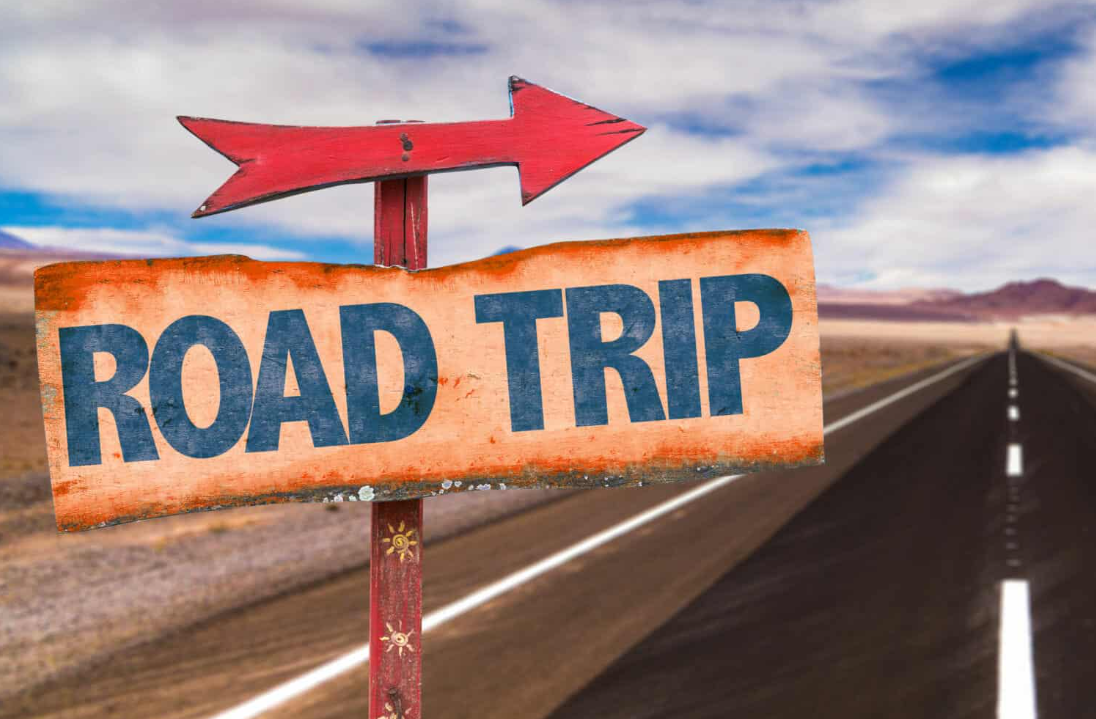
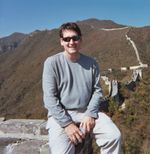
Member discussion: